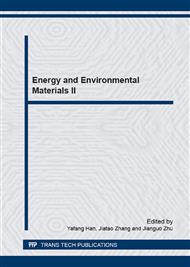[1]
P. Krulevitch, A. P. Lee, P. B. Ramsey, J. C. Trevino, J. Hamilton, M. A. Northrup, Thin film shape memory alloy microactuators, Journal of Micromechanical Systems. 5(1996), 270-282.
DOI: 10.1109/84.546407
Google Scholar
[2]
R. Andrews, M. C. Weisenberger, Carbon nanotube polymer composites, Current Opinion in Solid State and Materials Science. 8(2004), 31-37.
DOI: 10.1016/j.cossms.2003.10.006
Google Scholar
[3]
M. Moniruzzaman, K. I. Winey, Polymer nanocomposites containing carbon nanotubes, Macromolecules. 39(2006), 5194-5205.
DOI: 10.1021/ma060733p
Google Scholar
[4]
Q. F. Cheng, J. P. Wang, J. J. Wen, C. H. Liu, K. L. Jiang, Q. Q. Li, S. S. Fan, Carbon nanotube/epoxy composites fabricated by resin transfer molding, Carbon. 48(2010), 260-266.
DOI: 10.1016/j.carbon.2009.09.014
Google Scholar
[5]
M. B. Bryning, M. F. Islam , J. M. Kikkawa, A. G. Yodh, Very low conductivity threshold in bulk isotropic single-walled carbon nanotube–epoxy composites, Advanced Materials. 17(2005), 1186-1191.
DOI: 10.1002/adma.200401649
Google Scholar
[6]
H. Huang, C.H. Liu, Y. Wu, S. S. Fan, Aligned carbon nanotube composite films for thermal management, Advanced Materials. 17 (2005), 1652-1656.
DOI: 10.1002/adma.200500467
Google Scholar
[7]
L. B. Qiu, X. M. Sun, Z. B. Yang, W. H. Guo, H. S. Peng, Preparation and application of aligned carbon nanotube/polymer composite material, Acta Chimica Sinica. 70(2012), 1523-1532.
DOI: 10.6023/a12030024
Google Scholar
[8]
Y. L. Zhao, J. F. Stoddart, Noncovalent functionalization of single-walled carbon nanotubes, Accounts of Chemical Research. 42(2009), 1161-1171.
DOI: 10.1021/ar900056z
Google Scholar
[9]
A. Javey, J. Guo, M. Paulsson, Q, Wang, D. Mann, M. Lundstrom, H. Dai, High-field quasiballistic transport in short carbon nanotubes, Physical Review Letters. 92(2004), 106804.
DOI: 10.1103/physrevlett.92.106804
Google Scholar
[10]
P. J. F. Harris, Carbon nanotube composites, International Materials Reviews. 49(2004), 31-43.
Google Scholar
[11]
Y. Hu, G. F. Wang, X. M. Tao, W. Chen, Low-voltage-driven sustainable weightlifting actuator based on polymer-nanotube composite, Macromolecular Chemistry and Physics. 212 (2011), 1671-1676.
DOI: 10.1002/macp.201100151
Google Scholar
[12]
Y. Hu, W. Chen, Externally induced thermal actuation of polymer nanocomposites, Macromolecular Chemistry and Physics. 212 (2011), 992-998.
DOI: 10.1002/macp.201100068
Google Scholar
[13]
L. Z. Chen, C. H. Liu , C. H. Hu, S. S. Fan, Electrothermal actuation based on carbon nanotube network in silicone elastomer, Applied Physics Letters. 92(2008), 263104.
DOI: 10.1063/1.2955513
Google Scholar
[14]
L. Z. Chen, C. H. Liu , K. Liu, C. Z. Meng, C. H. Hu, J. P. Wang, S. S. Fan, High-performance, low-voltage, and easy-operable bending actuator based on aligned carbon nanotube/polymer composites, ACS Nano. 5(2011), 1588-1593.
DOI: 10.1021/nn102251a
Google Scholar
[15]
D. K. Seo, T. J. Kang , D. W. Kim, Y. H. Kim, Twistable and bendable actuator: a CNT/polymer sandwich structure driven by thermal gradient, Nanotechnology. 23(2012), 075501.
DOI: 10.1088/0957-4484/23/7/075501
Google Scholar
[16]
A. Govindaraju, A. Chakraborty , C. Luo, Reinforcement of PDMS masters using SU-8 truss structures, Journal of Micromechanics and Microengineering. 15(2005), 1303.
DOI: 10.1088/0960-1317/15/6/023
Google Scholar
[17]
L. Z. Chen, C. H. Liu, J. P. Wang, W. Zhang, C. H. Hu and S. S. Fan, Auxetic materials with large negative Poisson's ratios based on highly oriented carbon nanotube structures, Applied Physics Letters. 94 (2009), 253111.
DOI: 10.1063/1.3159467
Google Scholar
[18]
X. B. Zhang, K. L. Jiang, C. Teng, P. Liu, L Zhang, J. Kong, T. H. Zhang, Q. Q. Li and S. S. Fan, Spinning and processing continuous yarns from 4-inch wafer scale super-aligned carbon nanotube arrays, Advanced Materials. 18(2006), 1505-1510.
DOI: 10.1002/adma.200502528
Google Scholar
[19]
W. Riethmuller, W. Benecke, Thermally excited silicon microactuators, IEEE Transactions on Electron Devices. 35(1988), 758-763.
DOI: 10.1109/16.2528
Google Scholar
[20]
K. Liu, C. Cheng , Z. T. Cheng, K. Wang, R. Ramesh, J. Q. Wu, Giant-amplitude, high-work density microactuators with phase transition activated nanolayer bimorphs, Nano Letters. 12(2012), 6302-6308.
DOI: 10.1021/nl303405g
Google Scholar


